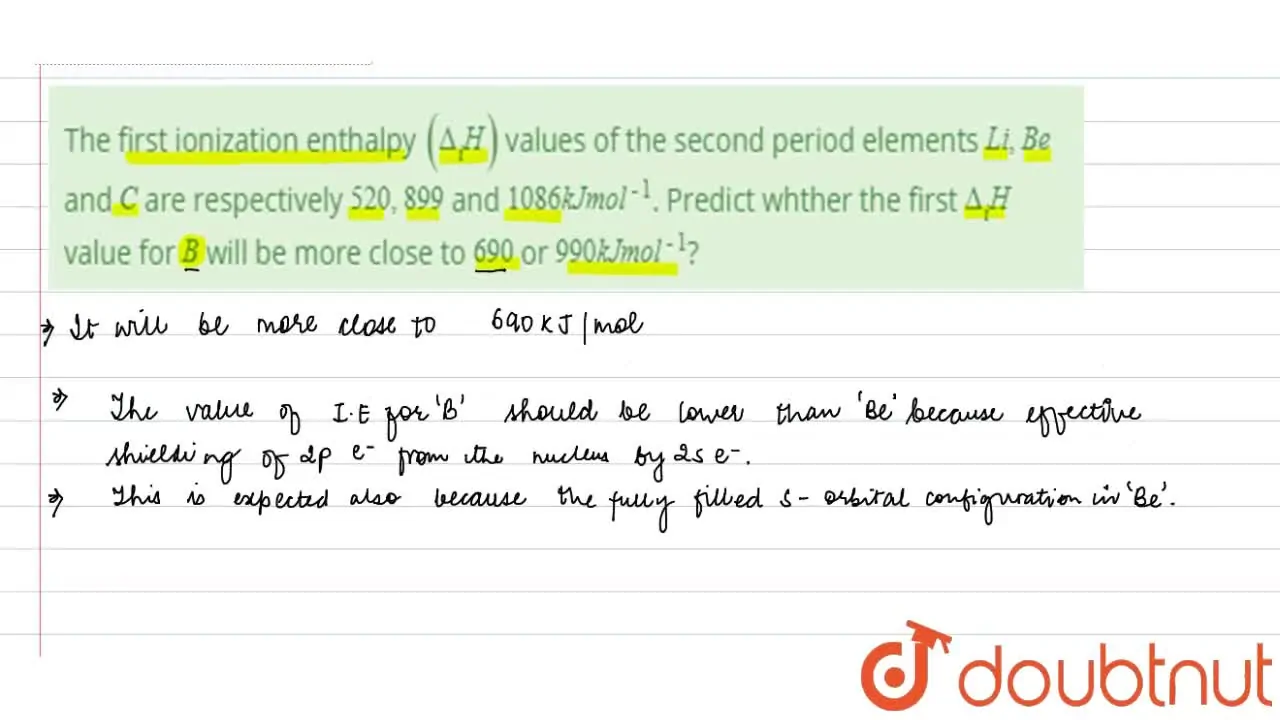The first ionization enthalpy (ΔiH) values of the second period elements Li,Be and C are respectively 520,899 and 1086kJmol−1. Predict whther the first ΔiH value for B will be more close to 690 or 990kJmol−1?
The correct Answer is:It will be more close to 690kJmol−1. The value for b should be lower than that of Be because of effective shielding of 2pelectrons from the nucleus by 2selectrons. This is expected also because of fully filled s−orbital configuration of Be.
Step by step video & image solution for The first ionization enthalpy (Delta_(i)H) values of the second period elements Li, Be and C are respectively 520, 899 and 1086 kJ mol^(-1). Predict whther the first Delta_(i)H value for B will be more close to 690 or 990 kJ mol^(-1)? by Chemistry experts to help you in doubts & scoring excellent marks in Class 12 exams.
Related Playlists
- BOOK - RESONANCE ENGLISHCHAPTER - PERIODIC TABLE & PERIODICITYEXERCISE - Exercise-11videos
PERIODIC TABLE & PERIODICITY
- BOOK - RESONANCE ENGLISHCHAPTER - PERIODIC TABLE & PERIODICITYEXERCISE - Exercise144videos
PERIODIC TABLE & PERIODICITY
- BOOK - RESONANCE ENGLISHCHAPTER - PERIODIC TABLE & PERIODICITYEXERCISE - MISCELLANEOUS SOLVED PROBLEMS7videos
PERIODIC TABLE & PERIODICITY
- BOOK - RESONANCE ENGLISHCHAPTER - P-BLOCK ELEMENTS (HALOGEN & NOBLE GASES)EXERCISE - APSP PART-322videos
P-BLOCK ELEMENTS (HALOGEN & NOBLE GASES)
- BOOK - RESONANCE ENGLISHCHAPTER - QUALITATIVE ANALYSISEXERCISE - INORGANIC CHMISTRY(Qualitative analysis)35videos
QUALITATIVE ANALYSIS
Similar Questions
The first ionisation enthalpy (ΔiHo−) values of the third period elements, Na,Mg and Si are respectively 496,737 and 786kJmol−1. Predict whether the first ΔiHo− value for Al will be more close to 575 or 760kJmol−1? Justify your answer.
View SolutionThe first ionization enthalpy (ΔtH) values of the third period elements, Na,Mg and Si are respectively 496, 737 and 786kJmol−1. Predict whether the first ΔtH valye for Al will be more close to 575 or 760kJmol−1? Justify your answer.
View SolutionIonisation enthalpy (ΔiH kJ mol−1) for the elements of group 13 follows the order.
View SolutionIonisation enthalpy (ΔtHlinkJmol−1) for the elements of group-13 follows the order
View SolutionThe first ionisation enthalpy values (in kJ mol−1) of group 13 elements are

How would you explain this deviation from the general , trend?View SolutionCorrect order of first ionization energy of the following metals Na, Mg, Al, Si in kJmol–1 respectively are:
View SolutionCorrect order of first ionization energy of the following metals Na, Mg, Al, Si in KJmol–1 respectively are:
View SolutionEnthalpy of formation of NH3 is -X kJ and ΔHH−H, ΔHN−H are respectively Y kJmol−1 and Z kjmol−1. The value of ΔHN=Nis
View SolutionGiven the bond energies of H−H and Cl−Cl are 430kJmol−1 and 240kJmol−1, respectively, and ΔfH∘ for HCl is −90kJmol−1. Bond enthalpy of HCl is
View SolutionThe first four I.E. values of an element are 284, 412, 656 and 3210 kJ mol−1. The number of valence electrons in the element are:
View Solution


